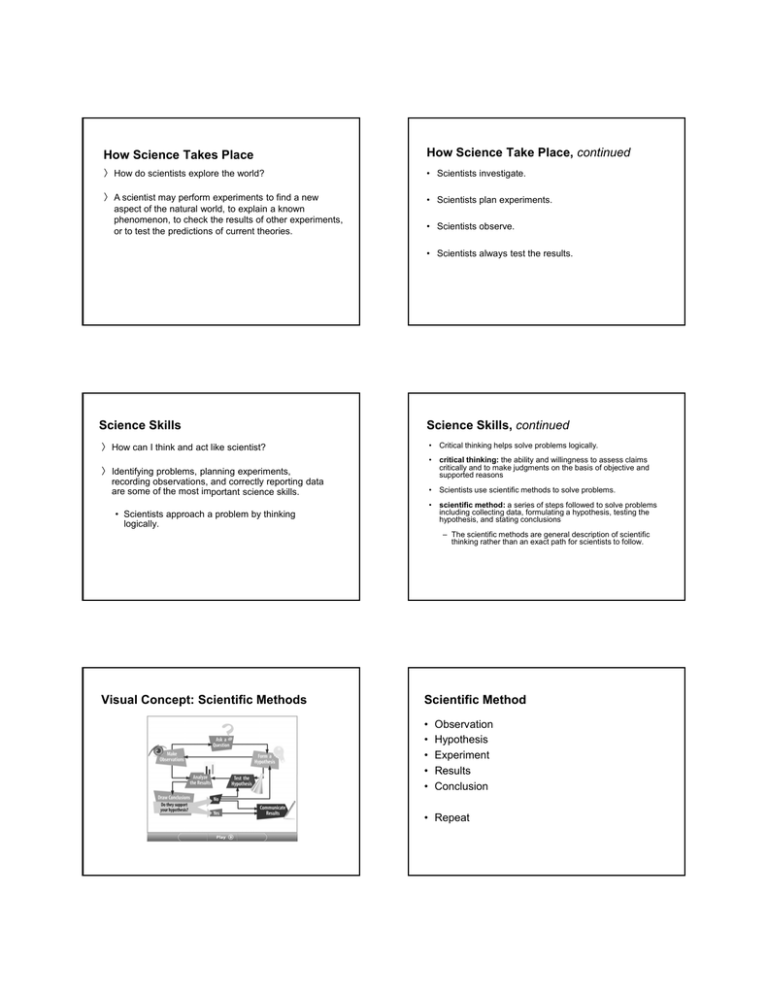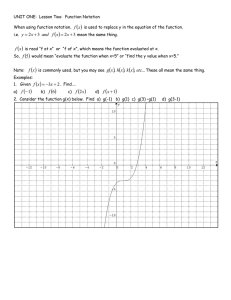How Science Takes Place How Science Take Place, continued
advertisement

How Science Takes Place How Science Take Place, continued 〉 How do scientists explore the world? • Scientists investigate. 〉 A scientist may perform experiments to find a new aspect of the natural world, to explain a known phenomenon to check the results of other experiments phenomenon, experiments, or to test the predictions of current theories. • Scientists plan experiments. • Scientists observe. • Scientists always test the results. Science Skills Science Skills, continued 〉 How can I think and act like scientist? • Critical thinking helps solve problems logically. • critical thinking: the ability and willingness to assess claims critically and to make judgments on the basis of objective and supported reasons 〉 Identifying problems, planning experiments, recording observations, and correctly reporting data are some of the most important p science skills. • Scientists use scientific methods to solve problems. • scientific method: a series of steps followed to solve problems including collecting data, formulating a hypothesis, testing the hypothesis, and stating conclusions • Scientists approach a problem by thinking logically. – The scientific methods are general description of scientific thinking rather than an exact path for scientists to follow. Visual Concept: Scientific Methods Scientific Method • • • • • Observation Hypothesis Experiment Results Conclusion • Repeat Science Skills, continued The Branches of Science • Scientists test hypotheses. 〉How are the many types of science organized? • hypothesis: a possible explanation or answer that can be tested 〉Most of the time, natural science is divided into biological science, physical science and Earth science. science – Scientists test a hypothesis by doing a controlled experiment. – controlled experiment: an experiment in which the variables that could affect the experiment are kept constant (controlled) except for the one that you want to measure – variable: a factor that changes in an experiment in order to test a hypothesis Visual Concept: Hypothesis • science: the knowledge obtained by observing natural events and conditions in order to discover facts and formulate laws or principles that can be verified or tested Science Skills, continued • Experiments test ideas. – No experiment is a failure. – The results of every experiment can be used to revise the hypothesis or plan tests of a different variable. – Peer-reviewed research: research that has been reviewed by other scientists The Branches of Science, continued • The branches of science work together. – biological science: the science of living things • botany, ecology – physical science: the science of matter and energy • chemistry: the science of matter and its changes • physics: the science of forces and energy – earth science: the science of the Earth, the atmosphere, and weather • geology, meteorology Visual Concept: Natural Science Visual Concept: Biology Visual Concept: Earth Sciences Visual Concept: Physics The Branches of Science, continued • Science and technology work together. – pure science: the continuing search for scientific knowledge – Advances in science and technology depend on each other. • technology: the application of science for practical purposes Scientific Laws and Theories Scientific Laws and Theories, continued 〉 What are scientific theories, and how are they different from scientific laws? • Experimental results support laws and theories. 〉 Theories explain why something happens, laws explain how something works. • law: a descriptive statement or equation that reliably predicts events under certain conditions – Scientific theories are always being questioned and examined. To be valid, a theory must: • explain observations • be repeatable • theory: a system of ideas that explains many related observations and is supported by a large body of evidence acquired through scientific investigation • be predictable Visual Concept: Comparing Theories and Laws Scientific Laws and Theories, continued • Theories and laws are always being tested. • Models can represent physical events. – model: a representation p of an object j or event that can be studied to understand the real object or event – Scientists use conceptual, physical, and computer models to study objects and events. • We use models in our everyday lives. Visual Concept: Models Units of Measurement 〉 How do scientists measure things? 〉 Scientists use standard units of measure that together form the International System of Units, or SI. Units of Measurement, continued • SI units are used for consistency. – SI has seven base units. – derived units: combinations of the base units SI (Le Système Internationale d’Unités) Units of Measurement, continued • SI prefixes are for very large and very small measurements. – The prefixes are multiples of ten. Math Skills Conversions within SI The width of a soccer goal is 7 m. What is the width of the goal in centimeters? – SI prefixes for large measurements 1 List the given and unknown values. 1. values Given: length in meters, l = 7 m Unknown: length in centimeters = ? cm Math Skills, continued Math Skills, continued 2. Determine the relationship between units. 1 cm = 0.01 m 4. Insert the known values into the equation, and solve. 1 m = 100 cm length in cm = 7 m × Multiply by 100 because you are converting from meters, a larger unit, to centimeters, a smaller unit. 3. Write the equation for the conversion. length in cm = m × 100 cm 100 cm 1m length in cm = 700 cm 1m Units of Measurement, continued • Measurements quantify your observations. • length: a measure of the straight-line distance between two points • mass: a measure of the amount of matter in an object • volume: a measure of the size of a body or region in three-dimensional space • weight: a measure of the gravitational force exerted on an object Visual Concept: Volume Bellringer Imagine your teacher asked you to study how the addition of different amounts of fertilizer affects plant heights. In your experiment, you collect the data shown in the table below. Use this data to answer the th ffollowing ll i questions. ti Bellringer, continued 1. Which amount of fertilizer produced the tallest plants? 2. Which amount of fertilizer produced the smallest plants? 3. Plot the data on a grid like the one below. 4 D ib th ll t d h f tili Presenting Scientific Data Presenting Scientific Data, continued • Why is organizing data an important science skill? • Line graphs are best for continuous change. • Because scientists use written reports and oral presentations to share their results, organizing and presenting data are important science skills. – dependent variable: values depend on what happens in the experiment • Plotted on the x-axis – independent variable: values are set before the experiment takes place • Plotted on the y-axis Line Graph i Presenting Scientific Data, continued • Bar graphs compare items. – A bar graph is useful for comparing similar data for several individual items or events. – A bar graph can make clearer how large or small the differences in individual values are. Bar Graph Presenting Scientific Data, continued Composition of a Winter Jacket • Pie graphs show the parts of a whole. – Ap pie g graph p is ideal for displaying data that are parts of a whole. – Data in a pie chart is presented as a percent. Writing Numbers in Scientific Notation Writing Numbers in Scientific Notation, continued 〉How do scientists handle very large and very small numbers? • Some powers of 10 and their decimal equivalents are shown below. 〉To reduce the number of zeros in very big and very small numbers, you can express the values as simple numbers multiplied by a power of 10, a method called scientific notation. • • • • • • • 103 = 1,000 102 = 100 101 = 10 100 = 1 10-1 = 0.1 10-2 = 0.01 10-3 = 0.001 • scientific notation: a method of expressing a quantity as a number multiplied by 10 to the appropriate power Writing Numbers in Scientific Notation, continued Math Skills • Use scientific notation to make calculations. Writing Scientific Notation The adult human heart pumps about 18,000 L of blood each day. Write this value in scientific notation. • When you use scientific notation in calculations, you follow the math rules for powers off 10. 10 • When you multiply two values in scientific notation, you add the powers of 10. • When you divide, you subtract the powers of 10. 1. List the given and unknown values. Given: volume, V = 18,000 L Unknown: volume, V = ? × 10? L Math Skills, continued Math Skills, continued 2. Write the form for scientific notation. Then, write 10,000 as a power of 10. V=?× 10? L 3. Insert the known values into the form, and solve. Find the largest power of 10 that will divide into the known value and leave one digit before the decimal point. 10,000 = 104 18,000 , L can be written as 1.8 × 104 L V = 1.8 × 104 L You get 1.8 if you divide 10,000 into 18,000 L. 18,000 L can be written as (1.8 × 10,000) L Visual Concept: Scientific Notation Math Skills Using Scientific Notation Your county plans to buy a rectangular tract of land measuring 5.36 x 103 m by 1.38 x 104 m to establish t bli h a nature preserve. What is the area of this tract in square meters? 1. List the given and unknown values. Given: length (l )= 1.38 × 104 m width (w) = 5.36 × 103 m 2 Math Skills, continued 2. Write the equation for area. A=l×w 3. Insert the known values into the equation, and solve. A = (1 (1.38 38 × 104 m) (5.36 (5 36 × 103 m) Regroup the values and units as follows. A = (1.38 × 5.36) (104 × 103) (m × m) When multiplying, add the powers of 10. A = (1.38 × 5.35) (104+3) (m × m) A = 7.3968 × 107 m2 A = 7.40 × 107 m2

